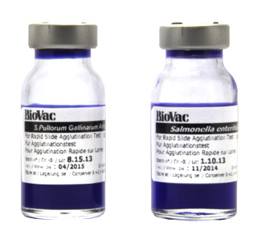Salmonella antigens
The regular monitoring of Salmonella in poultry is obligatory in many countries in Europe and the Americas.
Salmonella Enteritidis is the cause of food-borne infections via faecal contamination or more directly from eggs. Salmonella Pullorum Gallinarum causes severe infectious diseases in young poultry. This bacterium is spread from generation to generation via the eggs.
The Rapid Plate Agglutination (RPA) test is a technique based on the agglutination of antibodies produced by infected poultry with the suspension of Salmonella antigens, present in our products. Agglutination reveals the presence of circulating antibodies.
Advantages
Products
Reagents
- Salmonella Pullorum Gallinarum (Biovac) (ref: AS1)
- Salmonella Enteritidis (Biovac) (ref: AS2)
Control sera
- Specific pathogen-free (SPF) chicken serum (ref: AS7)
- Positive Salmonella Pullorum serum ref: AS5)
How to use the tests
Click below to download the instructions for use for the different rapid plate agglutination tests:
- Salmonella Pullorum Gallinarum antigen (Biovac)
- Salmonella Enteritidis antigen (Biovac)
- Specific pathogen-free (SPF) chicken serum
- Positive Salmonella Pullorum Gallinarum
Reading the results
The results are easy to read. Blue-violet agglutinates indicate a positive result and nothing happens when the result is negative. An aid to reading the results can be downloaded below. It includes photos of positive and negative results for each reagent:

 Corporate Website
Corporate Website
 Africa
Africa
 Argentina
Argentina
 Asia
Asia
 Australia
Australia
 Belgium
Belgium
 Brazil
Brazil
 Bulgaria
Bulgaria
 Canada (EN)
Canada (EN)
 Chile
Chile
 China
China
 Colombia
Colombia
 Denmark
Denmark
 Egypt
Egypt
 France
France
 Germany
Germany
 Greece
Greece
 Hungary
Hungary
 Indonesia
Indonesia
 Italia
Italia
 India
India
 Japan
Japan
 Korea
Korea
 Malaysia
Malaysia
 Mexico
Mexico
 Middle East
Middle East
 Netherlands
Netherlands
 Peru
Peru
 Philippines
Philippines
 Poland
Poland
 Portugal
Portugal
 Romania
Romania
 Russia
Russia
 South Africa
South Africa
 Spain
Spain
 Sweden
Sweden
 Thailand
Thailand
 Tunisia
Tunisia
 Turkey
Turkey
 Ukraine
Ukraine
 United Kingdom
United Kingdom
 USA
USA
 Vietnam
Vietnam


